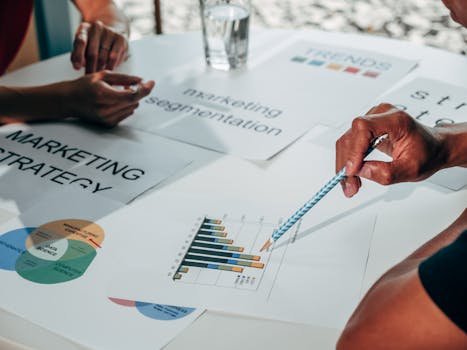Anúncios
Creating effective business materials is an essential skill for any entrepreneur or professional. High-quality materials not only promote your brand but also communicate your message clearly. This guide explores the steps and best practices for developing compelling business materials that captivate your audience.
Whether you are designing brochures, business cards, or digital presentations, the principles of good design and messaging apply universally. The aim is to create materials that reflect your brand’s identity while informing and engaging your target audience. With thoughtful planning and execution, you can produce materials that stand out and resonate with your stakeholders.
This article will provide an in-depth look at the processes involved in creating effective business materials. From understanding your audience to finalizing your designs, we will cover each critical step to help you produce results that elevate your brand and enhance communication.
Understanding Your Audience
Understanding your audience is the first step in creating business materials. Knowing who you are addressing helps tailor your content, design, and messaging. Segmenting your audience allows for more personalized communication.
Conduct surveys or interviews to gather information about your target demographics. Understand their needs, preferences, and pain points. This knowledge equips you with the insights needed to create relevant materials.
Anúncios
Utilizing analytics tools can also provide beneficial demographic data. Assess existing client interactions to gauge their interests. Analyzing patterns allows for better design and messaging alignment with audience expectations.
Keep the audience’s preferences in mind while deciding on the format of materials. Different audiences respond better to various mediums. Aligning your output with their preferences enhances engagement levels and effectiveness.
Lastly, staying updated with market trends can further refine your understanding. Continuous research leads to informed decisions that resonate more effectively with your target audience.
Anúncios
Defining Your Objectives
Defining clear objectives is crucial for the success of your business materials. Objectives help guide the creation process, ensuring you stay focused and aligned with your goals. Begin by outlining what you aim to achieve.
Consider setting specific goals, such as increasing brand awareness or driving sales. Each piece of material should reflect these objectives clearly. Different materials serve different purposes, which leads to varying objectives.
Using the SMART criteria helps in setting these objectives. This approach ensures your goals are Specific, Measurable, Achievable, Relevant, and Time-bound. Keeping your objectives SMART streamlines your focus and efforts.
Regularly reviewing and updating your objectives contributes to maintaining relevance and effectiveness. Markets evolve, and so should your material objectives. Adaptation based on trends ensures continued success.
Involve your team when defining objectives for their insights. Collaboration fosters a broader understanding and sets unified goals that contribute to creating cohesive materials. Everyone should be on the same page.
Choosing the Right Format
The format of your business materials plays a crucial role in their effectiveness. Different formats such as flyers, posters, and digital presentations serve various functions. Understanding which format to use is essential.
Consider the purpose of the material when choosing a format. For example, if you’re announcing an event, flyers may work best. On the other hand, presentations suit in-person meetings or webinars more appropriately.
Also, take into account your audience’s preferences. Some people may prefer printed materials, while others lean towards digital formats. Offering multiple options can cater to different preferences.
Review your brand identity to ensure that the chosen format aligns with it. Consistency across all formats builds a strong brand image. Visual brand elements such as colors and logos should be present in all materials.
Finally, test different formats and gather feedback from your audience. This approach allows you to gauge what resonates best, ensuring you can refine and adapt as necessary. Continuous improvement is key.
Designing Engaging Content
Engaging content is the cornerstone of effective business materials. The content should attract attention and communicate your message clearly and concisely. Start with a compelling headline that captures interest immediately.
Maintain simplicity in your language. Use everyday words and phrases that your audience can easily understand. Avoid jargon, as it often alienates the reader or viewer.
Visual elements like images, infographics, and charts can enhance understanding and retention. Incorporating visuals breaks up text, making the material more accessible and visually appealing.
Additionally, organize content logically. Use subheadings, bullet points, and short paragraphs to improve readability. A well-structured layout makes it easier for audiences to navigate your materials.
Lastly, always include a clear call-to-action (CTA). Whether it’s inviting readers to visit a website or attend an event, a strong CTA guides your audience on the next steps to take.
Incorporating Branding Elements
Branding elements are vital in making your business materials recognizable. Consistency in branding across all materials strengthens your brand identity and builds trust. Start by using your company logo prominently.
Choose a color palette that aligns with your brand identity. Consistent color usage across materials projects professionalism and cohesiveness. Your selected typography should also reflect your brand’s character.
Ensure that all branding elements are aligned with your target audience’s expectations. For example, a tech-savvy audience may appreciate a modern and sleek design, while a traditional audience might prefer classic aesthetics.
Utilize templates that incorporate your brand’s style into various formats. Templates streamline the design process, ensuring all materials remain consistent. Consider software tools that facilitate template creation and use.
Moreover, train your team on your branding guidelines. Consistent usage ensures that everyone creates materials that embody your brand values. A well-trained team helps maintain a unified brand image.
Reviewing and Refining Your Materials
Reviewing and refining your materials is essential before they reach the public. Take the time to proofread all content thoroughly, checking for typos, grammatical errors, and inaccuracies. Mistakes can undermine professionalism.
Gather feedback by consulting colleagues or focus groups. Others may offer fresh perspectives on effectiveness and clarity. Emphasize constructive criticism to foster improvement opportunities.
Utilize A/B testing for digital materials, allowing you to compare different designs or copy. Testing can guide you toward the most effective options for your audience. Analyze results to make data-driven decisions.
Keep track of any changes made based on feedback or testing. Maintaining a record will clarify what works best and can inform future material creation processes. Continual improvement leads to better outcomes.
Finally, ensure compliance with any necessary regulations or standards related to your materials. This includes copyright laws, naming conventions, and industry-specific guidelines. Proper compliance protects your business and builds credibility.
Conclusion
Creating effective business materials is a multifaceted process that combines understanding your audience, defining objectives, choosing formats, designing content, and incorporating branding elements. Careful review and refinement will enhance your materials’ effectiveness. By following these steps, you can produce materials that clearly convey your message, increase engagement, and elevate your brand.
Invest time and effort into each step of this process, and you’ll see significant improvements in how your materials perform in the market. Remember, effective business communication contributes significantly to overall business success.
With the right tools and planning, you can consistently create business materials that support your goals and help you connect with your audience meaningfully.



